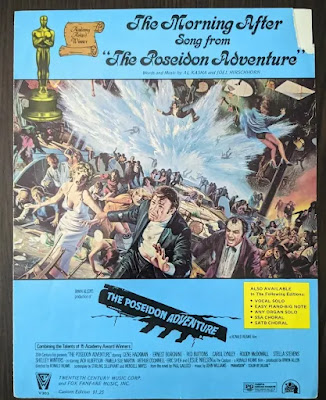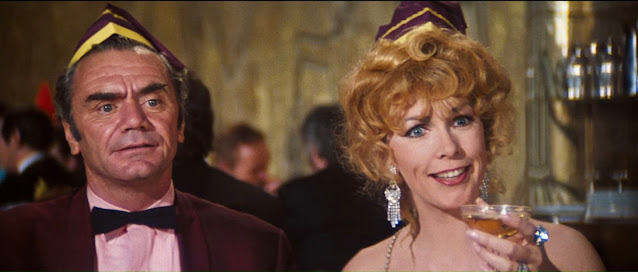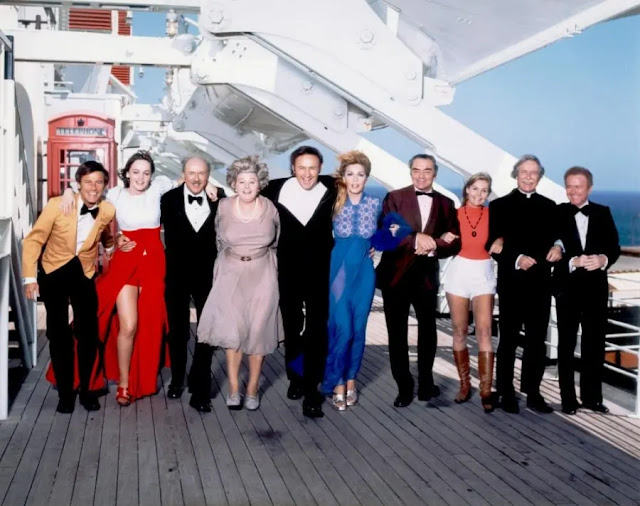Get ready to face a different kind of scare this October - disaster films!
Many people find themselves feeling a bit uneasy when it comes to disaster movies, and it's understandable why. These films can be quite brutal, often touching on themes of mass death. But at the same time, there's something strangely captivating about them, much like horror movies.
While there may be some cliched messages tucked away in there, the way the stories unfold can be pretty wild and unpredictable, particularly when it comes to the fates of the characters. In the end, these movies usually morph into simple adventure tales about regular folks just trying to survive in the face of overwhelming adversity. So let's get started with a film I try to watch every New Year's Day.

 |
| "There's got to be a morning after"... |
Attention passengers and crew of the SS Poseidon!
Imagine yourself on the brink of a disaster, trapped inside an overturned luxury liner, with only a small group of survivors led by a preacher standing between you and safety. This is the harrowing situation on the SS Poseidon as it embarks on its final voyage from New York City to Athens before being scrapped. But as fate would have it, a tsunami strikes on New Year's Day, leaving you upside down and fighting for survival.
Now is the time to come together, follow the guidance of this preacher, and make a united effort to find a way out of this dire situation. Your lives depend on your ability to work as a team, to trust in the leadership of this preacher, and to never lose hope.
Get ready for the ultimate disaster movie adventure brought to you by 20th Century Fox and the legendary Master of Disaster, Irwin Allen! Featuring an all-star cast including five Oscar winners (Gene Hackman, Ernest Borgnine, Shelley Winters, Jack Albertson, and Red Buttons) head the cast, along with a mix of familiar faces (Stella Stevens, Leslie Nielsen, Carol Lynley, Arthur O’Connell, and Roddy McDowall) and young newcomers (Pamela Sue Martin and Eric Shea). The cast and crew maneuvered through flames, traversed ductwork and shafts, climbed inverted ladders and staircases, navigated twisted metal, and waded through abundant pools of water as they documented their trek toward the hull, the sole section of Poseidon still visible above the surface.

Director Ronald Neame filmed in chronological order, allowing the characters’ increasingly soiled faces, battered bodies, and ragged clothing to mirror the actors' real-life challenges. The film has always captivated my attention from start to finish. It's a rare gem in the world of disaster films, one that truly stands the test of time. Despite its imperfections, I can see why it's still an entertaining film. From over-the-top acting, the funny lines, and the sermons amid a visually thrilling experience that is both frightening and emotionally impactful.
The movie was a huge hit, and second grossing film of that year making over $125 million globally. It was up for eight Academy Awards and managed to snag two Oscars (Song and Visual Effects), a Golden Globe, a British Academy Film Award, and a Motion Picture Sound Editors Award.
- Esther Williams was initially offered the role that eventually went to Shelley Winters, as her swimming abilities made her a natural fit for the part. However, her husband Fernando Lamas, who had a strong influence over her career decisions, did not want her to appear on screen in a less-than-flattering way. Esther was disappointed that she did not end up making the film.
- Many took on their own stunts and began to push themselves to outperform each other including the two-time Oscar winner Winters, who, at 51, added 35 pounds to authentically portray a former swimming champion swimmer and grandmother. She was never able to lose the weight after that. Actor Ernest Borgnine shared that there was a palpable sense of eagerness before they embarked on executing the daring stunts.
- The passenger (Ernie Orsatti) who fell into a ceiling light fixture after the luxury liner was overturned by a tidal wave was paid $100 for the stunt and go it in one take. This led to him becoming a stuntman and coordinator.
- This was based on a novel by Paul Gallico from 1969. Gallico, started his career writing for magazines like The Saturday Evening Post in the 1930s and '40s. He got some of his story ideas from a tale shared by a crew member on the Queen Mary, which almost flipped over due to a massive rogue wave during its time as a troop ship in World War II. Interestingly, the film's opening scenes were filmed on the Queen Mary right after it was turned into a floating hotel in Long Beach, California.
- Red Buttons and Carol Lynley had a strong dislike for each other while shooting. They avoided any interaction outside of their scenes together. Interestingly, despite this tension, they eventually formed a close friendship in the years that followed.
- Married couple aboard the ship Ernest Borgnine and Shelley Winters ended up playing a married couple on an episode of The Love Boat in 1982.
Academy Award winner Gene Hackman cuts cake on set of his new film, The Poseidon Adventure,
at 20th Century Fox. Other members of cast who previously had won
Oscars join in celebration. From left are Jack Albertson, Red Buttons,
Ronald Neame (director), Hackman, Shelley Winters and Ernest Borgnine.
Hackman won an Oscar for role as a tough detective in The French Connection.




























1 comment:
Loved your post -- The Poseideon Adventure is far and away my favorite of the disaster films, and I can't count how many times I've seen it. I especially enjoyed your facts -- except for Shelley's inability to lose the weight she gained, I never knew any of these, and I ate them up like popcorn! (I think you meant Stella Stevens in the picture about the Love Boat episode -- I will have to look for that one!) I especially liked learning about the passenger who became a stunt man and about Red Buttons and Carol Lynley! Good stuff!
Karen (Shadows and Satin)
Post a Comment